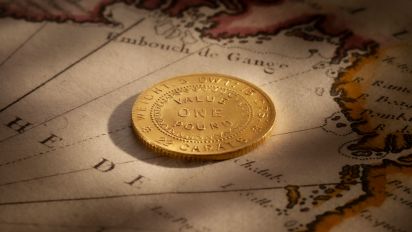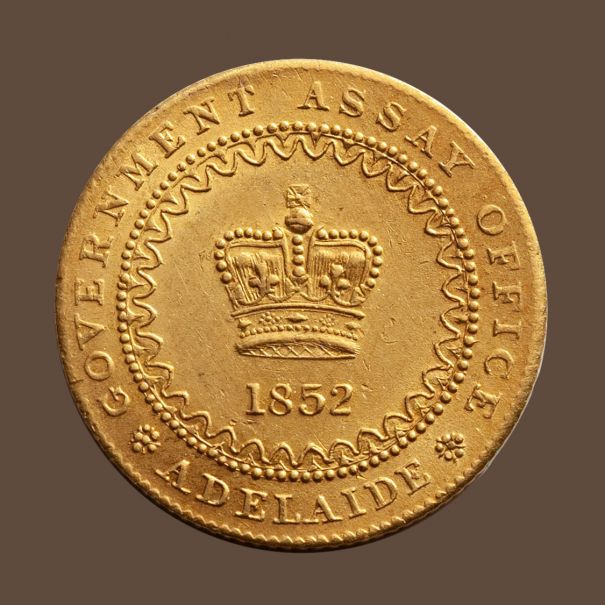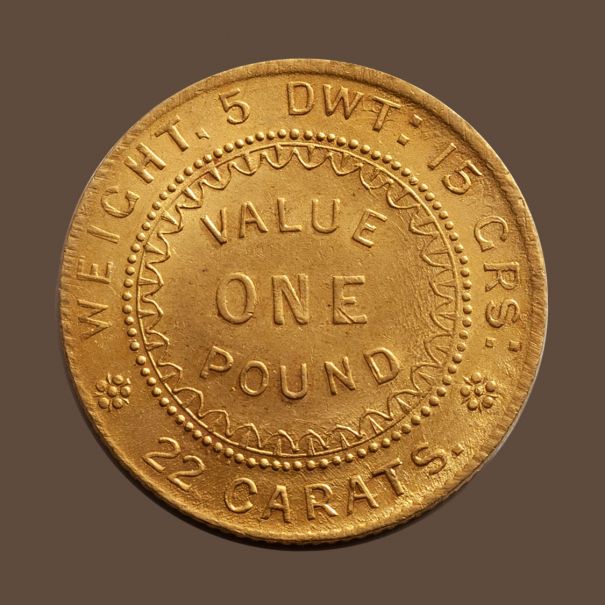1852 Adelaide Assay Office Gold One Pound struck with the second reverse die (Type II)



The 1852 Adelaide Pound holds a very special place in Australia's history as the nation's first gold coin.
It is a classic Australian numismatic rarity, as is the 1813 Holey Dollar and 1813 Dump, the Square Penny and the 1930 Penny.
Its status as Australia’s first gold coin ensures that it will always be sought after and strengthens its investment value.
Its investment value is also enhanced by its rarity for we estimate that perhaps two hundred and fifty examples are available to collectors, across all quality levels.
Examining an Adelaide Pound is a three-point process.
1. Start off by looking at the coin in the flesh using just the naked eye. A genuinely nice coin will always look good to the unaided eye.
This coin is lustrous on both obverse and reverse. The legend GOVERNMENT ASSAY OFFICE is strong. Collectors should know that most Adelaide Pounds struck with the second die show extreme weaknesses in the legend. This coin is an exception to those we normally see.
There are no obvious defects or gouges. It's an overall well balanced coin with great eye appeal.
2. Take up the magnifying glass.
The eye glass re-confirms what we have seen with the naked eye ... and much more. The coin has undergone minimal circulation, the highpoints of the design, the fleur de lis and the cross on the orb on the crown showing a slight touch of usage.
There are no unsightly gouges or marks. As gold is a soft metal, the rigours of circulation have treated most examples harshly. Not so with this coin!
3. And lastly, take another look with the naked eye just to make sure that you have taken everything in.
The final assessment of this Adelaide Pound is that it is a great coin and passes our three-point assessment with flying colours.
It is indeed a coin you would be proud to show family and friends.


1852 Adelaide Pound, About Uncirculated and lustrous with minimal marks in the field. Note the strength in the legend 'Government Assay Office Adelaide'.

1852 Adelaide Pound struck at the Government Assay Office using the second reverse die that featured a scalloped inner border abutting a beaded inner circle
History of the 1852 Adelaide Pound
The discovery of gold in the 1850s is one of the most extraordinary chapters in Australian history, transforming the economy. And transforming our society for it marked the beginnings of a modern multi-cultural Australia instigated by mass migration, particularly from China.
Several coins were spawned by the Gold Rush, including our first gold coin, the 1852 Adelaide Pound.
It was struck in Adelaide at the South Australian Government Assay Office without the sanction of the British Government or the approval of Queen Victoria.
To validate their actions in circumventing Royal protocols, the South Australian Legislators found a loophole in the Government’s regulations and passed the Bullion Act, that allowed them to create their own mint and strike gold ingots. And eventually strike gold coins.
The Bullion Act No 1 of 1852 has a record unique in Australian history. A special session of Parliament was convened to consider it. Parliament met at noon on the 28 January 1852.
The Bill was read and promptly passed three readings and was then forwarded to the Lieutenant Governor and immediately received his assent. It was one of the quickest pieces of legislation on record, with the whole proceedings taking less than two hours.
Thirteen days after the passing of the Act, on 10 February 1852, the Government Assay office was opened. Its activities were supported by a state government initiative to provide armed escorts to bring back the gold from the Victorian diggings.
The Assay Office was effectively Australia's first mint, be it unofficial. Its sole purpose was to assay gold nuggets brought from the Victorian goldfields and to re-shape them into ingots. No minting expertise was required in the casting of the ingots.
Nine months later, following agitation from Adelaide’s business community, legislation was passed that authorised the Government Assay Office to strike gold coins. Within a week of opening, 600 gold Adelaide Pounds had been delivered to the South Australian Banking Company, 100 of which were sent to London.
Suddenly precision was required. The design was intricate, created by colonial die sinker and engraver, Joshua Payne. So, it was always going to be a tough ask for a factory to start churning out currency to a defined weight and design.
The Bullion Act had a lifetime of only twelve months.
By the time the legislative amendments were passed to enact the production of gold coins, the Act had less than three months to run. As a consequence, only a small number of Adelaide Pounds were struck and very few actually circulated. The official and recorded mintage of the nation’s first gold coin, the 1852 Adelaide Pound, was 24,648.
When it was discovered that the intrinsic value of the gold contained in each piece exceeded its nominal value, the vast majority were promptly exported to London and melted down.
The 1852 Adelaide Pound was as unofficial as you could get but it saved the colony of South Australia from bankruptcy. A simple case where the end justified the means.
© Copyright: Coinworks